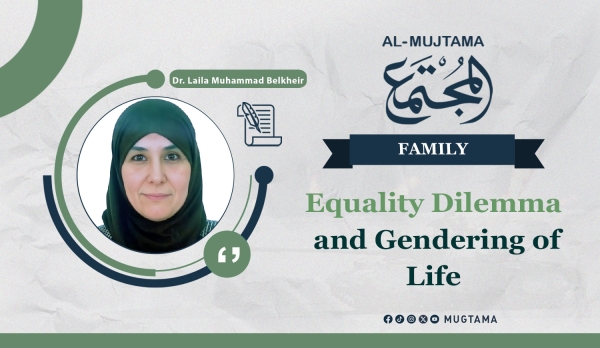Whenever Western feminists call for the necessity of combating violence against women, violence increases, destroying all elements of the family. And whenever they call for equality and the elimination of all forms of discrimination against women, disintegration and discord intensify, fueling the flames that consume everything in their path. Moreover, whenever they demand the erasure of distinctions and the unification of gender roles, along with the gendering of life, women's responsibilities and burdens outside the home increase. This leads to their preoccupation away from their natural educational role within the home and disrupts the role of men as men, thereby dismantling the gender-based division of humanity and allowing for hybrid and deviant forms to dominate human existence.
For this reason, this study attempts to examine these terms by referring to the intellectual frameworks that produced them and by returning to the philosophical foundations to understand the terminology within its Western context. It also seeks to analyze its movement and implications within the culture of the Arab family to comprehend the crisis that feminist theorists fell into when formulating these terms. This is because these terms inherently carry striking contradictions and profound dilemmas that are both perplexing and astonishing at the same time.
Western Feminism's Impact on Family Stability and Identity
1- Equality and the Problem of Identicalness Between Two Unequal Genders
The term “equality” emerged modestly during the Renaissance and the Industrial Revolution, especially with the entry of women into the labor market and working in factories alongside men. At that time, women began to struggle and demand equal wages and working conditions, seeking equal opportunities with men and the elimination of disparities.
Over time, the concept evolved further to accommodate the current slogan of “eliminating all forms of discrimination against women.” This, however, has led to a major problem: recognizing the absolute identicalness of two genders that are entirely different. The irony is that the term implicitly acknowledges differences (such as the recognition of women's roles in childbirth and pregnancy) while simultaneously insisting that women should be able to take on men's tasks in any position. Outwardly, the concept focuses on improving women's conditions worldwide, but at its core, it is a form of enslavement and an insult to the feminine nature.
Equality between men and women means the complete erasure of distinctions between them. It also implies increased burdens and responsibilities for women and fuels conflict between men and women over privileges.
Despite feminists’ efforts to draft laws, conventions, and treaties that promote equality, fairness, and opposition to all forms of violence, feminist theorist Sarah Gamble states that feminism has robbed women of their right to be sexually attractive, to enjoy domestic bliss, and that it has destroyed the family, leaving children to grow up without proper moral guidance. She also asserts that feminism has led to increased violence against women and incidents of femicide. (1)
Thus, in the name of equality, the nature of women has been distorted, turning them into grotesque, multi-headed, multi-eyed, multi-limbed creatures. The modern woman has acquired some characteristics of men and some of women because she has fallen into the trap of equality that she herself created and adopted. As a result, she can neither be a complete woman nor a fully realized man!
Symbolic Violence or the Symbolism of Violence
The illusion of equality leads women to challenge their nature by attempting to fulfill all roles simultaneously. They strive to break records and immerse themselves emotionally in playing the role of the “superwoman,” just like a video game heroine. Lost in the mirage of control, the intoxication of power, and the illusion of authority, they waste the prime of their lives proving their competence in men's roles, forgetting their fundamental role as women.
Unfortunately, this is the harshest form of violence a woman can inflict upon herself—it is symbolic violence, or the symbolism of violence. She has no defense against it because it is hidden, insidious, and its impact is devastating and difficult to escape.
The paradox and profound crisis lie in the feminists' efforts to improve the conditions of women in the so-called “backward” world by formulating strict laws, agreements, and conventions to oppose all forms of violence against women. However, while this may appear to be the goal on the surface, the hidden agenda is to erase distinctions in religion, values, culture, and all aspects of life.
The shocking outcome of these efforts is that violence, in all its forms, is increasing—not only against women but also against men and against humanity itself. This violence manifests through various channels: music, television series, advertisements, fashion trends, and more. These insidious recommendations fuel conflict, leaving women with the only means of survival being the destruction of men. The modern image of the “superwoman” who defeats all men and stands triumphantly over their corpses is a monstrous distortion—it is neither woman nor man. This is the modern, “advanced” model, which opposes all traditional forms of femininity, particularly as they call it “submissive” woman who stays at home, nurturing her children and fulfilling the noblest role in human history—childbearing and upbringing. This is a role that no one else can perform, and one that she herself cannot fulfill unless she embraces her true femininity.
2- The Term Gender and the Problem of Unified Roles Between the Sexes
The definition of “gender” relates to social and political constructs distinct from the biological concept of sex. It seeks to unify gender roles and eliminate differentiation in responsibilities between men and women. From this perspective, the term “gender” encompasses three main roles: “reproductive, productive, and societal.” (2)
It refers to the cultural, social, and historical characteristics attributed to men and women and is sometimes described as the study of masculinity and femininity. Gender is thus a term used to distinguish cultural sex from biological sex and sexuality as a practice. (3)
This has led to fluidity and the promotion of individual freedom in choosing gender identity, embracing gender transition, and rejecting the Fitrah (innate nature) that Allah has created. The term itself is laden with contradictions and serves as a gateway to challenging the natural gender division of humanity (male or female). Consequently, individuals can choose to be neither male nor female, transition between genders, (4) or remain neutral. It also serves as a euphemism for deviant or effeminate identities, along with other terms carrying ideological implications that oppose human nature.
Gender Norms or the Gendering of Life
Understanding gender identity and sexual orientation reveals that global organizations explicitly acknowledge homosexuality and “gender identity.” This refers to an individual's deep-seated internal experience of gender, regardless of the gender recorded on their birth certificate. It includes their perception of their own body and may involve altering their physical appearance or functions through medical or surgical means. (5)
Sexual orientation refers to a person’s emotional, romantic, and sexual attraction to individuals of the opposite sex, the same sex, or multiple genders, and their engagement in intimate relationships with them. (6)
In this regard, Kamilia Helmy provides extensive explanations distinguishing between “sexually transitioned individuals” and “gender transitioned individuals.” Both involve transitioning from one gender to another, but gender-transitioned individuals are more adept at disguise and deception. A person born male can be legally recognized as female through hormonal treatments or surgeries, and vice versa. However, sexually transitioned individuals cannot change their genetic makeup or acquire the reproductive capabilities of the gender they transition into. (7)
A transgender individual refers to a person whose identity does not align with their biological sex. The term “transgender” is particularly dangerous to society because the concept of “sexually transitioned individuals” is outright rejected by the public, whereas “gender-transitioned individuals” operate under the guise of ambiguity and concealment. They retain their biological sex while adopting different behaviors in their clothing, attitudes, and personality. (8)
This concept is subtly introduced through visual culture, which manufactures acceptance and submission by frequently portraying women in men's roles and men in women's roles. This repeated exposure serves as a form of normalization, fostering familiarity and habituation toward immorality, making it less repulsive to audiences. Over time, the issue of gender roles has become a central topic in contemporary discourse, giving rise to the feminist demand for equal division of responsibilities between men and women within the family. This is framed as a means to unify work patterns and achieve complete equality, ultimately erasing gender distinctions and making way for abnormal and hybrid identities.
This movement seeks to distract women from their natural educational role within the family by enticing them to excel in men's roles and prove their superiority in performing them. Simultaneously, it aims to dismantle the role of masculinity and male authority within the family and society, paving the way for moral decay, effeminacy, and the erosion of innate human nature. This results in a state of chaos and degradation, stripping humanity of its authentic identity and values.
-------------------------------------------------------------
(1) Sarah Gamble, The Routledge Companion to Feminism and Postfeminism, p. 81.
(2) Drucilla Cornell et al., Global Concepts of Gender, translated by Antoine Abou Zeid, Morocco, 1st ed., 2005, p. 62.
(3) A group of authors, New Conceptual Terms, p. 262.
(4) David Glover, Cora Kaplan, Genders, translated by Adnan Hassan, Dar Al-Hiwar, 1st ed., 2008, pp. 28-29.
(5) International conference in Yogyakarta, Indonesia, November 6-9, 2006, where principles protecting the rights of homosexuals, queers, and transgender individuals were endorsed.
(6) Kamilia Helmy Toulon, International Treaties and Their Impact on the Destruction of the Family, p. 70.
(7) Kamilia Helmy, International Treaties, pp. 78-79.
(8) Ibid., p. 79.


